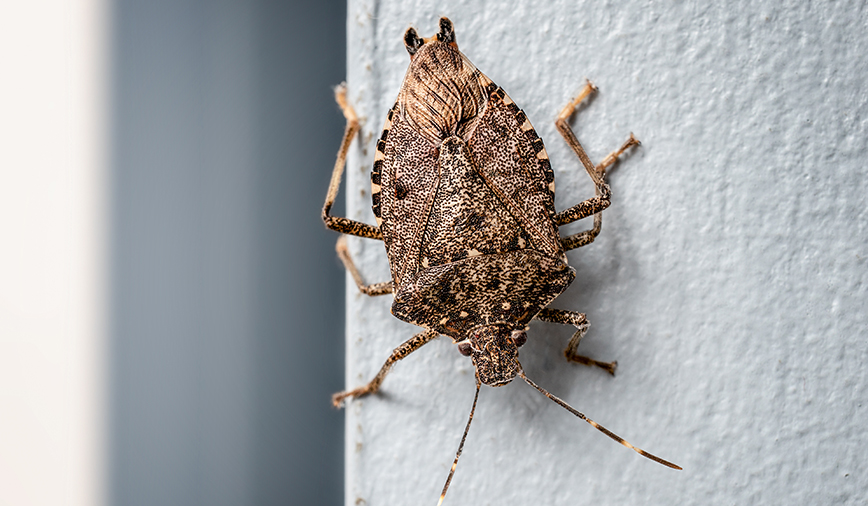“Stink.”
It’s the kind of word that makes people cringe. Beyond its primary definition of “having a strong, unpleasant odor,” it also can be used to indicate a fuss or uproar—”raising a stink”—as well as opine that something is lousy, as in an idea or situation that stinks.
“Bug.”
Here’s another word that can make folks uncomfortable. Even though it first and foremost denotes the noun insect—which, I understand, can be a negative as well as a positive—the word also is used to describe a germ, an error or a surveillance device; as a verb it’s even worse, meaning “to annoy or irritate.”
But if you really want to get people talking, put those two words together. “Stink bug” is term that we’ve heard a lot about lately, with good reason. The little critters have been everywhere this year—in gardens, on screens, on patio furniture. And now that it’s gotten cold, they’re inside homes, annoying, irritating and just generally raising a stink.
I suppose first we should clarify that stink bugs, as a family, Pentatomidae, are quite a varied bunch. Although all have the same basic body shape, sort of a shield with five sides, and antennae with five segments (qualities that led to the “penta’ part of the family name) the group diverges widely into five subfamilies and well over 200 species in North America alone.
Some feed on plants and are considered pests; others feed on insects and are considered beneficial. Each of our native species has a correlating set of control mechanisms, either in the form of predators or parasites. And all of them, to some degree, release a chemical defense when disturbed.
But there’s one species in our area that has people really bugged. The brown marmorated stink bug, Halyomorpha halys, started moving indoors at the first hint of cold weather. It joins three other insects–multicolored Asian lady beetles, western conifer seed bugs and box elder bugs—in leaving its mark on windowsills, curtains, walls and ceilings. As a result, it’s become marked itself–for removal.
As a naturalist and lover of all bugs, I always have a hard time recommending ways to “get rid of” anything. But that doesn’t stop the calls from coming. And so I’ve taken to the internet to see what the experts recommend as far as minimizing indoor populations of BMSBs.
Two common removal methods—squishing and vacuuming—are known to be effective, but not necessarily odorless. Remember, these guys release their stink when disturbed. And really, what could be more disturbing that having your exoskeleton crushed, or sucked up at high velocity?
Sprays are not recommended, due to their toxic nature. Plus BMSBs don’t bite, chew or otherwise cause harm, so there’s no need for overkill.
Commercial traps are available but, according a study conducted at Polytechnic Institute and State University, a.k.a. Virginia Tech, in Blacksburg, VA, a simple homemade contraption offers higher rates of capture at a fraction of the cost. A gooseneck lamp positioned over an aluminum roasting pan holding an inch or so of water with a squirt of dish detergent in it was shown to be the most effective means of capturing BMSBs—rates as high as 20 insects per week were recorded.
For anyone concerned that mass removal of BMSBs might create a problem in local ecosystems, you needn’t worry. These bugs are nonnative, having been accidentally introduced to the eastern United States in the 1990s. Since then the mobile species—yes, they can fly—has traversed the country and has found something like 300 different plant species to its liking. It’s now found in over 40 states and recognized as an agricultural pest in 19 of them.
BMSBs can be differentiated from native species by the contrasting banded segments on their antennae. Well, that and their tendency to overwinter indoors. Native stink bugs, conversely, prefer to remain outdoors, tucked under leaf litter or within crevices in bark.
A Good Natured column isn’t complete without a photo, so the other day I set out to take a picture of one of the two BMSBs I’ve seen in my house this fall. Aided by my cat Jimmy, an expert bug spotter, I soon found one of our target species hunkered quietly beneath the sponge drainer on the kitchen sink.
Having heard that the bug’s odor smells something like cilantro, I was secretly hopeful I’d get a whiff. Throughout the ensuing 45-minute photo session, I poked the bug, prodded the bug, and refrigerated and repositioned the bug many times. It showed off its banded antennae and its prominent scutellum—the large triangle on its back. Once it even flew, landing on my back. A fair amount of contorting on my part, along with a helpful tap from Jim, got the bug back where I could reach it.
Eventually we got a picture taken. But, I’ve gotta say, I’m not entirely happy. The image is a little blurry, for one thing. But most disappointingly, the passive little bug never—not even once—raised a stink.
Pam Otto is the manager of nature programs and interpretive services at the Hickory Knolls Discovery Center, a facility of the St. Charles Park District. She can be reached at 630-513-4346 or potto@stcparks.org.

